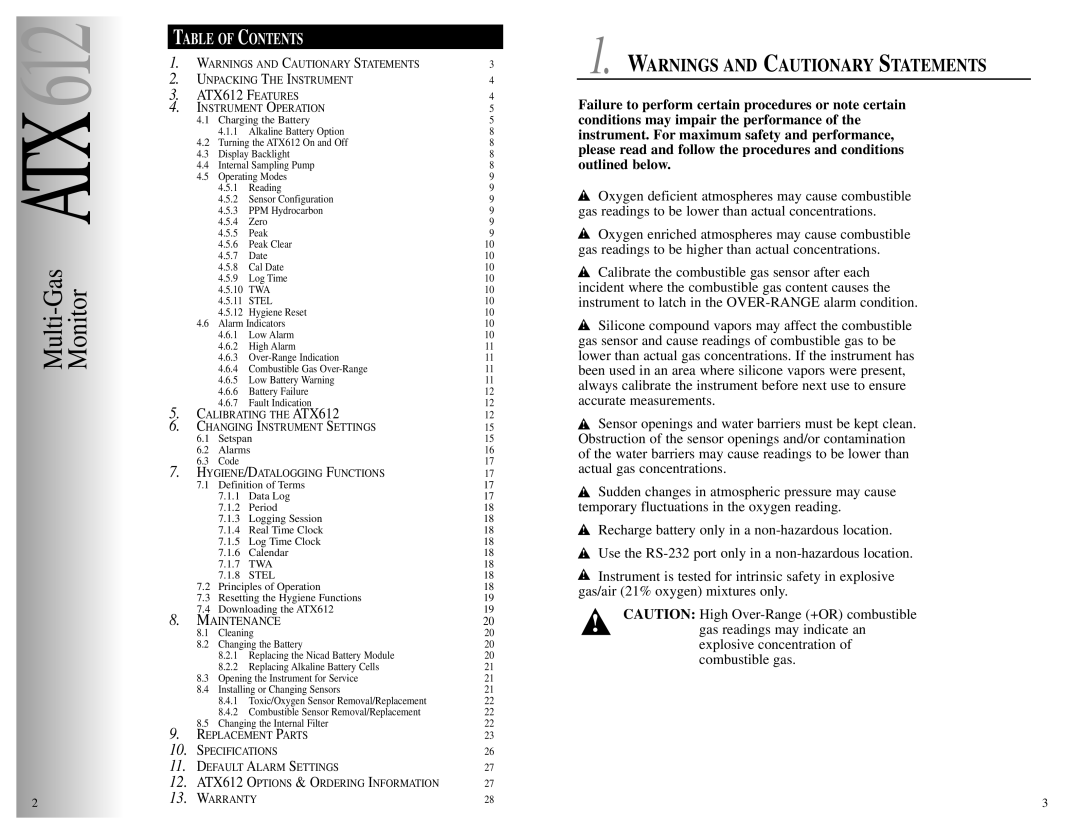
2
TABLE OF CONTENTS
1. | WARNINGS AND CAUTIONARY STATEMENTS | 3 | ||
2. | UNPACKING THE INSTRUMENT | 4 | ||
3. | ATX612 FEATURES | 4 | ||
4. | INSTRUMENT OPERATION | 5 | ||
| 4.1 | Charging the Battery | 5 | |
|
| 4.1.1 | Alkaline Battery Option | 8 |
| 4.2 | Turning the ATX612 On and Off | 8 | |
| 4.3 | Display Backlight | 8 | |
| 4.4 | Internal Sampling Pump | 8 | |
| 4.5 | Operating Modes | 9 | |
|
| 4.5.1 | Reading | 9 |
|
| 4.5.2 | Sensor Configuration | 9 |
|
| 4.5.3 | PPM Hydrocarbon | 9 |
|
| 4.5.4 | Zero | 9 |
|
| 4.5.5 | Peak | 9 |
|
| 4.5.6 | Peak Clear | 10 |
|
| 4.5.7 | Date | 10 |
|
| 4.5.8 | Cal Date | 10 |
|
| 4.5.9 | Log Time | 10 |
|
| 4.5.10 | TWA | 10 |
|
| 4.5.11 | STEL | 10 |
|
| 4.5.12 | Hygiene Reset | 10 |
| 4.6 | Alarm Indicators | 10 | |
|
| 4.6.1 | Low Alarm | 10 |
|
| 4.6.2 | High Alarm | 11 |
|
| 4.6.3 | 11 | |
|
| 4.6.4 | Combustible Gas | 11 |
|
| 4.6.5 | Low Battery Warning | 11 |
|
| 4.6.6 | Battery Failure | 12 |
5. |
| 4.6.7 | Fault Indication | 12 |
CALIBRATING THE ATX612 | 12 | |||
6. | CHANGING INSTRUMENT SETTINGS | 15 | ||
| 6.1 | Setspan | 15 | |
| 6.2 | Alarms | 16 | |
7. | 6.3 | Code |
| 17 |
HYGIENE/DATALOGGING FUNCTIONS | 17 | |||
| 7.1 | Definition of Terms | 17 | |
|
| 7.1.1 | Data Log | 17 |
|
| 7.1.2 | Period | 18 |
|
| 7.1.3 | Logging Session | 18 |
|
| 7.1.4 | Real Time Clock | 18 |
|
| 7.1.5 | Log Time Clock | 18 |
|
| 7.1.6 | Calendar | 18 |
|
| 7.1.7 | TWA | 18 |
|
| 7.1.8 | STEL | 18 |
| 7.2 | Principles of Operation | 18 | |
| 7.3 | Resetting the Hygiene Functions | 19 | |
8. | 7.4 | Downloading the ATX612 | 19 | |
MAINTENANCE | 20 | |||
| 8.1 | Cleaning | 20 | |
| 8.2 | Changing the Battery | 20 | |
|
| 8.2.1 | Replacing the Nicad Battery Module | 20 |
|
| 8.2.2 | Replacing Alkaline Battery Cells | 21 |
| 8.3 | Opening the Instrument for Service | 21 | |
| 8.4 | Installing or Changing Sensors | 21 | |
|
| 8.4.1 | Toxic/Oxygen Sensor Removal/Replacement | 22 |
|
| 8.4.2 | Combustible Sensor Removal/Replacement | 22 |
9. | 8.5 | Changing the Internal Filter | 22 | |
REPLACEMENT PARTS | 23 | |||
10. | SPECIFICATIONS | 26 | ||
11. | DEFAULT ALARM SETTINGS | 27 | ||
12. | ATX612 OPTIONS & ORDERING INFORMATION | 27 | ||
13. | WARRANTY | 28 | ||
1. WARNINGS AND CAUTIONARY STATEMENTS
Failure to perform certain procedures or note certain conditions may impair the performance of the instrument. For maximum safety and performance, please read and follow the procedures and conditions outlined below.
!Oxygen deficient atmospheres may cause combustible gas readings to be lower than actual concentrations.
!Oxygen enriched atmospheres may cause combustible gas readings to be higher than actual concentrations.
!Calibrate the combustible gas sensor after each
incident where the combustible gas content causes the instrument to latch in the
!Silicone compound vapors may affect the combustible gas sensor and cause readings of combustible gas to be lower than actual gas concentrations. If the instrument has been used in an area where silicone vapors were present, always calibrate the instrument before next use to ensure accurate measurements.
!Sensor openings and water barriers must be kept clean. Obstruction of the sensor openings and/or contamination of the water barriers may cause readings to be lower than actual gas concentrations.
!Sudden changes in atmospheric pressure may cause temporary fluctuations in the oxygen reading.
!Recharge battery only in a
!Use the
!Instrument is tested for intrinsic safety in explosive gas/air (21% oxygen) mixtures only.
CAUTION: High
! gas readings may indicate an explosive concentration of combustible gas.
3
